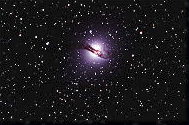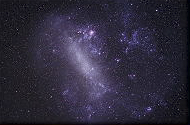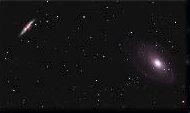Galaxies
Gallery 1 || Gallery 2 || Gallery 3

Centaurus A |

LMC (Large Magellanic Cloud) |

Supernova |
Galaxies
Galaxies are massive, gravitationally-bound assemblies of stars, stellar remnants, the interstellar medium consisting of gas and dust, and dark matter, nonluminous material which is as yet poorly understood and can be detected only by its gravitational influence. The term galaxy is derived from the Greek “galactos” or milky, with reference to the milky appearance of our own galaxy, the Milky Way. Galaxies range in size from dwarfs with just a few tens of millions stars, to gigantic structures containing trillions of stars.
In addition to encompassing varying numbers of star systems, star clusters and types of interstellar clouds, galaxies probably also host varying numbers of planets, as well interstellar gas and dust. Supermassive black holes likely also reside at the core of most galaxies and are the primary drivers of active galactic nuclei. Our Milky Way galaxy is known to harbor at least one such object.
Historically galaxies have been categorized according to their apparent shape or as they appear visually. Elliptical galaxies present ellipse-shaped profiles, while spiral galaxies are typically disk-shaped with dusty, curving arms. Irregular or unusual shaped galaxies are thought to result from gravitational disruption due to interaction with neighboring galaxies. Gravitational interactions between nearby galaxies, which may ultimately lead to mergers, can trigger high levels of star formation leading to starburst galaxies. Messier-82 is one such galaxy lying relatively close to us. Small galaxies lacking any particular morphology are often called dwarf galaxies. The Magellanic Clouds, visible only in the southern hemisphere, are irregular dwarf galaxies orbiting our Milky Way.
There are likely in excess of 170 billion galaxies in our observable universe, 1,000 to 100,000 parsecs in diameter and typically separated by distances of millions of parsecs (1 parsec = 3.26 light years). The space between galaxies is filled with very tenuous gas of an average density less than one atom per cubic meter. Most galaxies are organized into associations known as galaxy groups and clusters, and these in turn, into larger associations (superclusters). The latter are widely distributed into strand-like filaments, which are encircled by immense voids.
Klaus Brasch
Outreach || Flagstaff || Photos || Articles || Observing Sites || Weather
Coordinated Universal Time || National Weather Service
info@coconinoastro.org

